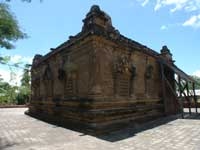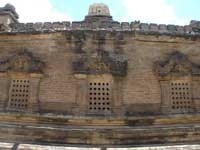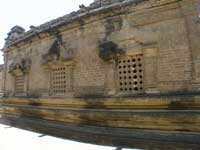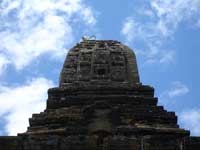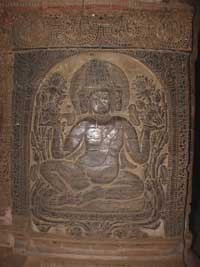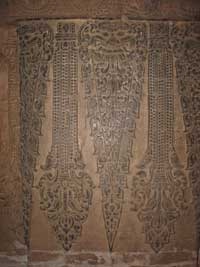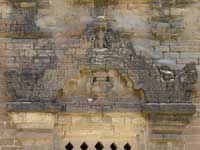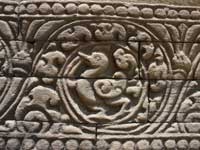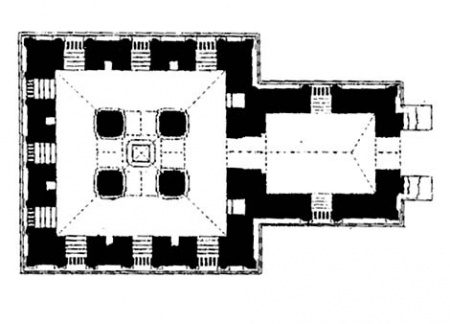Nanpaya Temple
- Type of monument : Type III Temple (Kundaung Pauk Gu)
- Location : Close behind Manuha
- Region : Myinkaba
- Built by : King Manuha's grand-nephew, Prince Naga Thaman
- Date : 11th Century
- Monument Number : 1239
Close behind the Manuha Pagoda, there is a shrine mostly known as "Nanpaya". It is said to have been used as Manuha's prison although there is little evidence supporting the legend.
There is also another story saying that the shrine was originally Hindu. Supposedly his captors thought that using it as a prison would be easier than converting it to a Buddhist temple. But also some say that the temple was built by Manuha's grand-nephew known as Prince Naga Thaman in the late 11th century.
SANDSTONE CARVINGS INSIDE THE TEMPLE
It is made of sandstone masonry block facings integrated over a brick core. It is particularly fine. It consists of perforated stone windows which are typical of earlier Bagan architecture. Nanpaya is in fact Bagan's first "gu-style" (cave) shrine. It also features interesting arches over the windows.
MARVELOUS STUCCOS ON THE RIM OF THE TEMPLE
In the central sanctuary the four stone pillars have finely carved sandstone bas-relief figures of four-faced Brahma। The creator deity is holding lotus flowers, thought to be offerings to a free-standing Buddha image once situated in the shrine's centre, a theory that dispels the idea that this was ever a Hindu shrine। The sides of the pillars bear ogre-like heads with open mouths streaming with flowers। According to the Myanmar legend, the face of the orge represents the guardian and eats flowers instead of meat।
LAYOUT PLAN
ARCHITECTURE
Nan Hpaya
This small, compact and in all senses perfect gu temple is also said to date from the reign of Anawrahta and if so, must be the first free standing Buddhist cave at Pagan. One tradition, though a spurious one, assigned this temple as being the palace of Manuha, the captive MON king. Taw Sein Ko questioned whether it was indeed a Buddhist temple, for there is no image enshrined and the stone reliefs of Brahma on the piers were to him evidence of a Hindu connection. However, the central pedestal could have born an image of the Buddha, possibly life size and standing, for there is a skylight above that would have illuminated a figure of such dimensions.
The Nan phaya and the contemporary Kyauk ku ohn min temple are the only two temples at Pagan where stone was widely used. It is a soft sandstone of warm hues and satisfying texture. The quality o masonry in both of these temples is very fine: note the wary the blocks tightly integrate with each other with practically no use of mortar. The main structure is actually brick, the stone work being a facing for aesthetic or protective purposes and imitating the form of brick. It would seem strange if this stone facing was originally completely whitewashed over, with its ornament polychromed and gilded as was usual in Pagan temples. On close examination on the exterior, and moreover the interior, ornament polychrome traces are still evident.
The exterior composition is simple in its conception, perhaps even slightly restrained. the porch and its pediment are now lost, the masonry at the base indicating the one time existence of such a porch, extending outwards from the east facing hall. The hall has a window placed at the medial points of its north and south walls. Windows on the Nan hpaya are perforated so as to filter or ration the quantity of light admitted. Each is suronuted by a pediment carried on single pilasters with an undramatic capital between pilaster and pediment. These cinquefoil pediments are low lying, unlike the soaring later types with heightened spinodes. The tympana, between the lintels and cinquefoils, contain a kalasa pot, a motif from India, that was also applied here on the Nan phaya in profile form along the plinth. This window arrangement is repeated for the shrine, where there are three openings to each side of the three open sides of the base. As for the actual stone perforations, these are made up of a diamond pattern, something like a trellis. In subsequent temples, like the Abe ya dana, various perforation designs alternate with each other, in an attempt to dispel monotony. However, there is little monotony to be experienced at the Nan hpaya.
Running in continuous bands round the base are the plinth moldings, the central one is the same kalasa pot in profile., first found at Pagan on the Nat hlaung Kyaung. Above this, at the level of the pilaster bases,runs a subtle dado frize carved fromthe stone bricks. The dado is comprised of a band of tondos, ech tondo framing the figure of a hamsa, a mythical aquatic brid of Indian origin. This motif is often repeated in mural paintings, for example, the Myinkaba Kubyauk gyi, and acquired great popularity in later times. Here at the Nan hpaya, the hamsa too makes its Pagan debut. On the upper part of the exterior wall beneath the entablature, is the kirtimukha frieze. Of breathtaking beauty, it aslo has bee chiseled from the surface of the stone bricks either before they were laid or once in position. This work is contemporary with the Kyauk Ku Ohn min stone work, where a near identical vocabulary of decorative motifs was employed. The style of stone carving at Kyauk Ku is also close to the Nan hpaya's, though, perhaps on account of the greater scale of the Kyauk ku, the stone carved ornament on its exterior is less delicate whilst bolder and more visually impressive. The Kyauk ku ohn min door jambs are claimed to be traceable to similar jambs in Bengal and a convincing argument for an indigenous derivation, for the Brahma relief's physiognomy within the Nan hpaya is Mongoloid not Indo Aryan. The other Pagan decorative motif that namenting the pilasters, that also is later translated into the stucco medium, is the corner pilaster featuring the downwards pointing V incorporting a kirtimukha.
After this time, exterior temple ornament would rarely be carved in the medium of stone again, perhaps on account of the rarity of this medium, and these innovative motifs and forms were translated into the medium of stucco, a medium in which contemporary artists were more familiar as Early Pagan has absorbed the Pyu stucco working traditions into its own artistic life. So, the question recurs, from whence did the artists who worked here and at Kyauk ku come? Were they local men working in a local tradition of which there are no other vestiges? Or, perhaps, the work of Mon artists transported as booty by Anawrahta back to his capital, as the chronicles tell? Alternatively, was this was the work of imported Indians who modified physiognomy to suit the local taste? What ever, it must be noted that there is a dichotomy between the prodigious virtuosity of this atelier, who were concerned with ornament, and Anawrahta's Buddha images which are far cruder in their execution and surely the work of different hands.
The hall vault is masked by two simple crenellated terraces and over the shrine a third one runs beneath the sikhara. The medial openings protruding about the base of the sikhara are sky lights. Rising from the steep, horizontal lines of the base moulding is the sikhara, a vertical stroke countering the horizontality of the temple's sub structure. The east face retains the sunken round and square panels that were originally a feature of all four faces. If this work does belong to the reign of Anawrahta, and there is no reason to invalidate this tradition, then this must be the first sikhara of this type at Pagan, unlike the Pyu type found on the Nat hlaung kyaung. Again, the origi of this form is unclear, it does not seem to have been known to the Pyu so it may well hve been an import from India. On Anawrahta's votive tablets similar forms are to be seen, acting as a reredos to the central figure. Anawrahta at this rejected the Pyu type found on the Nat hlaung kyuang. Again the origin of this form is unclear, it does not seem to have been known to the Pyu so it may well have been an import from India. On Anawrahta's votive tablets similar forms are to be seen, acting as a reredos to the central figure. Anawrahta at this time rejected the Pyu type of tablet that had included nine scenes from the life of he Buddha, in favour of the more regular Pala type with eight scenes, and tablets from Bodh Gaya have been found from this time at Pagan. This type of sikhara with square base and curved, tapering, upwards and inwards panels, something like the jatamukuta or crown ornament, was the current form used in contemporary north east India. It may have been carried to Burma in this portable medium to influence temple design. This whole super structure is set well within the low lying terraces and there is none of the steep, energetic climb of the Nat hlaung-kyaung.
The plan is a simple two unit, one of hall and one of shrine. The sikhara is carried by four freestanding piers. The space between them is directly beneath the central mass above. Sky lights tansmit a dim light down onto the empty pedestal upon which the Buddha must have stood. Freestanding, it my have been made of bronze. Here, the central core of the Nat hlaung kyaung and Pyu prototypes is hollowed to create the cella framed by the four massive piers. It is the next logical step in the evolution of the Pagan temple, after the Nat hlaung kyaung and the first Buddhist one. Immediately above the restored pedestal is an upper open space with four openings through the base of the sikhara, here is also a cornice running about the four sides of this upper open space. However behind this, in the vault between the two west piers, is a further aperture. It may be conjectured that, originally, the image stood between these piers, and not the centre., and that the upper space, inside the base of the sikhara, was in fact an attic, with boards covering the opening held by the cornice. The present pedestal, as has been noted, is a restored on e and it is uncertain whether the original would have stood in this position.
Perhaps the finest feature of the whole temple are the stone relief carvings of the Hindu deity, Brahma, characterized by the four heads at right angles to each other. There are four of these Brahma reliefs, one on the inner face of each pier looking into the cella towards where the image would have stood. The carving of these reliefs is of outstanding sumptuousness, their production a prodigious moment for Pagan. Carved from not a single slab but from stone blocks that interlock, they are reminiscent of the stone carving techniques of Java or Cambodia. Brahma is carried on a lotus cushion that extends sinuous stems to encompass his body with lush buds. Set within a semi-circular arch, framed y curvacious line carvings and surmounted by a richly carved Kirtimukha frize, this manner of treating Brahma in relief on stone was never to be repeated again in Burma, though Brahma, the god, who has been met earlier at the Nat hlaung kyuang, was a well known deity to the Pyus and old Mons. Alwas, Brahma is secondary to buddha; it would be a grave mistake to suggest that the Nan hpaya was a Brahmanic temple.
The pediments that span between the piers, masking the arches, are related to the ones on the exterior, which are cinquefoils with spinode ornamentation first found at Pagan at the Nat hlaung kyuang, but a form known to the pyu. Here the cinquefoil pediment is developed to the next stage in which it is superimposed upon a tiered arrangement resembling a pyatthat. This arrangement was, by the end of the Early Period, to be applied to exterior window ornamentation, for example at the Myinkaba Kubyauk gyi. Interesting here is the inclusion of leogryphs on the lower horizontal protrusion. This device was, though, not to be repeated in later renditions of this form.
On the remaining three sides of the four piers that same V feature of the exterior pilasters is elaborated. The carver's chisel self-confident, his creations hang down as if richly textured banners. Fragments of mural paintings may be seen in the hall vaults: these must be among the earliest surviving paintings in Burma.
